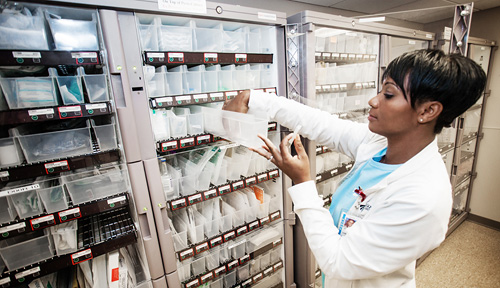It’s 10 a.m. at Brown County Hospital in Ainsworth, Neb., and time for medication.
As the nurse stands at the medication cabinet getting the meds ready, a lab tech approaches with test results.
When she walks down the hall toward the patient’s room, a doctor approaches with some instructions and just before she enters the room a nursing assistant stops her to ask a question.
“What should only take five minutes turns into a 20-minute task,” said Tammy Brown, a registered nurse and director of nursing at the hospital.
With each interruption the chance for errors increases, Brown said.
Gary Cochran, Pharm.D., assistant professor of pharmacy practice in the UNMC College of Pharmacy, wants to help rural hospitals decrease the chance for errors.
Through a five-year, $650,000 training grant from the Agency for Healthcare Research and Quality, Dr. Cochran has completed one study and is launching a second comparing the effectiveness of medication use systems in reducing errors in a sampling of the 65 critical access hospitals in rural Nebraska.
The purpose of the grant is to help researchers learn new methodologies through hands-on experience, formal training and oversight by senior investigators.
Dr. Cochran used a unique practice-based evidence study design and new analytic techniques to better address the limitations of observational study designs.
In the next study, data collection forms will be developed entirely by the participants, allowing them to identify relevant questions, Dr. Cochran said.
“We will provide assistance with design, data collection and analysis,” he said.
The goal of both studies is to compare the different systems — bar coding, tele-pharmacy or a full-time pharmacist — that dispense medication to patients and the impact they have on reducing errors.
“More than 400,000 harmful medication errors occur each year in the United States,” Dr. Cochran said. “While significant advances have been made in large hospitals, little research has been conducted in the 1,300 critical access hospitals across the nation, where differences in personnel, infrastructure and care delivery processes make it hard to generalize findings from large urban facilities.”
In his first study of nine rural hospitals, including Brown County Hospital, Dr. Cochran evaluated more than 3,000 medication passes by nursing staff through direct observation by peers.
The technique allowed the participating facilities to discover their own strengths and weaknesses when it came to patient care, Brown said.
The impact from the first study already is evident at Brown County Hospital, where the findings helped hospital administrators implement technology to support clinical staff throughout the medication process, she said.
Those implementations included the purchase of an automated medication dispensing machine, as well as the addition of a licensed practical nurse and pharmacy technician who both work full-time in the pharmacy.
“And we’re looking into getting medication dispensing carts for the nursing staff,” Brown said.
Five of the nine hospitals that participated in the first research study are signed on for the next one, which will begin by May 2013.
“We want to see if the changes we’ve made have had an impact and if there are other areas of weakness that need attention,” Brown said.
That’s good news for Dr. Cochran, who is pleased his research is useful to the hospitals.
“Our hope is to improve medication safety, reduce harmful medication errors and improve the quality and efficiency of health care for those living in and traveling through rural America,” he said.
